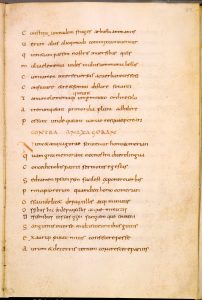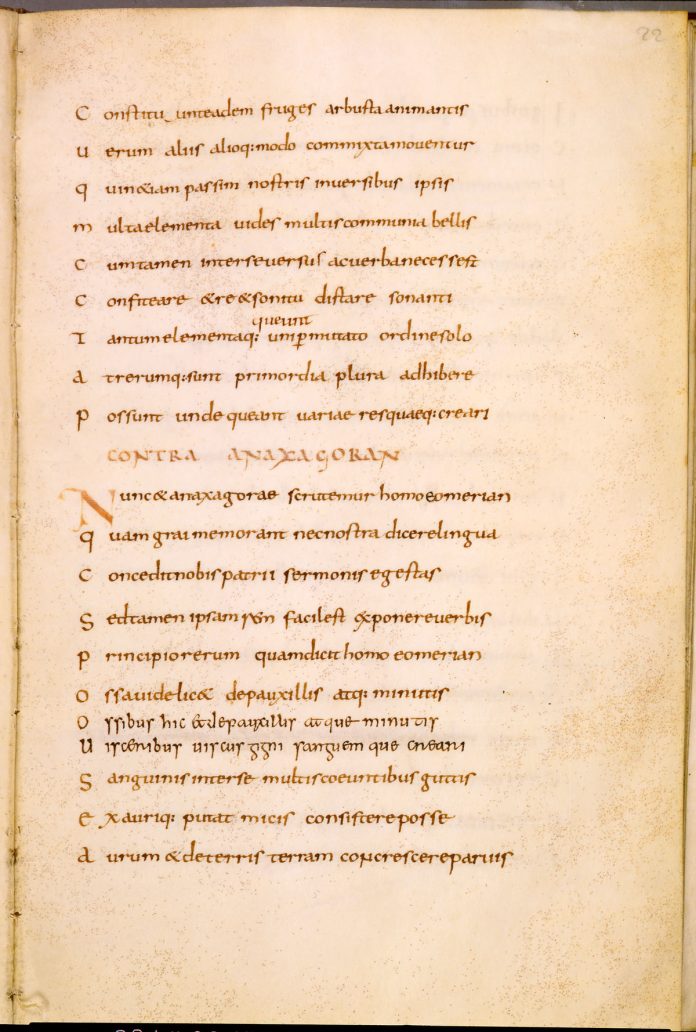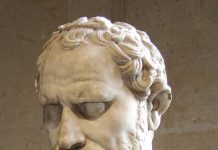Whole books have been written about De rerum natura, a long poem written by Lucretius (99-55 BCE). Its intended audience were Romans, who wanted to learn about the Greek school of thought known as Epicurean philosophy. Since that text by Epicurus included the notion (ascribed to Democritus) that atoms exist, it has proved to be a foundational text for modern science: the realization that atoms really exist only dates from the 20th century.
(for my review of a book on De rerum natura, see the story in Sun News
The Origin of Atoms: https://sunnewstucson.com/?s=gellar-goad)
While thousands of students have studied the poem, few know how it survived for more than 2,000 years. We are lucky to have it. As author Violet Moller tells us in this book, it was not found until 1417, when a fellow named Poggio came across it “on a dusty shelf in the depths of a monastic library” near Lake Constance (northern Italy). It was “a book that had not seen the light of day for centuries,” writes Moller, “about which there had only been rumours. Condemned and suppressed by the Church for over a millennium, this lyrical, complex epic poem contained ideas that were so threatening to the existing order it was a miracle that it had survived at all.”
The oldest manuscripts of the poem that survive are held in the library of Universiteit Leiden: Voss. Lat. F. 30, from the early 9th century nicknamed O; and Voss. Lat. Q. 94, nicknamed Q. Corrections (some of which were wrong) were made to the O manuscript early in the eleventh century. These appear in the one found by Poggio, proving the book Poggio found was a descendant of O. This is fascinating stuff, but none of it appears in Moller’s book. This is not meant as a criticism; I merely outline this to show that in such a short book she had to gloss over a lot of detail. Those interested in further background should consult the 10 pages of notes on offer, followed by an 8-page bibliography. The book also contains 33 B&W illustrations.
The discovery of the Lucretius manuscript (obviously copied several times in the 1500 years since it was written), is one of the most recent tales of detective work Moller examines. She begins in the period usually termed The Dark Ages, those centuries immediately after the fall of the Western Roman Empire. Her book traces how ancient knowledge was preserved, and most importantly where and by whom. She begins in Alexandria (Egypt), moving to different locales as the shifting currents of time carried knowledge: Baghdad, Cordoba and Toledo (Spain), Salerno (Italy), Palermo (Sicily), and finally Venice.
It is a dazzling book, with well-paced prose and the irresistible lure that comes with finding old stuff of great value. Only in this case intellectual value, although those early finds are now priceless manuscripts.
While Europe was still in the Dark Ages, Baghdad was a thriving centre of learning; the caliph Harun, who took power in 786, built the House of Wisdom that contained a library. One of his descendants built a palace “which had an annexe with accommodation and study rooms for scholars.” Public libraries in the West began in the 18th century: in Baghdad there were several of them more than a thousand years ago. In addition, the city “was full of private libraries; they became the ultimate status symbol.” If only that were true today! The Emperor of the Eastern Roman Empire donated a chest full of scientific books to Baghdad; as early as 650, a scholar had already written a treatise on astronomy based on his study of Ptolemy’s Almagest, which even then was an antique of some 500 years.
The scene then shifts to Cordoba, where an emir from Syria brought the science of horticulture. When he died in 788, Cordoba “was a flourishing center of commerce and civilization.” By 870, his descendant Muhammad I “created a royal library that was the largest collection of the time,” which prompted other wealthy people to bid up the prices of rare books so high scholars could not afford them! Sounds just like modern times.
The book craze caught on with everyone who wanted to learn ancient wisdom. A case in point in Gerbert d’Aurillac who excitedly wrote the Archbishop of Rheims in 983 that he had found “eight volumes: Boethius De astrologia, also some beautiful figures of geometry.” A few years later Gerbert became Pope Sylvester II.
With an obvious passion for her detective story, Moller (who has a PhD in intellectual history from the Univ. of Edinburgh) goes on tell of the key European figures who translated the Arabic works into Latin, since all the original Latin texts from ancient Rome had vanished. And of course, the ancient Greek texts as well, which initially very few people in Europe could read.
She writes of one manuscript in particular in the following sentence, but it can represent the tale of many other such finds: “The web of transmission of these manuscripts is extremely complex, but it is possible to trace definite, yet delicate, connections.”
A book that is a delight to read, and one that will increase for all the appreciation we should feel for those scholars who laboured for centuries to rebuild civilization from the ruins of ancient Greece and Rome.
The index has its faults. For example, Poggio is listed in the index as appearing first on 225; his entry begins on 224.
The Map of Knowledge: A thousand-year history of how classical ideas were found and lost. Published in softcover by Anchor Books for $17.95.














